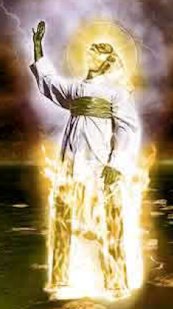"A New Approach to Revelation" by Tricia Tillin (Part Twelve)
how the day of atonement Temple service sheds light on the book of revelation - The 42 Months
Now we have come to that part of the Yom Kippur service that was most sacred and awe-inspiring to the Temple worshippers and priests, the actual atonement (or, expiation) of their collective sins. However, what was most significant and sacred to the Jews is in fact - in the book of Revelation - passed over almost without a mention!
Why is that? It is because the afternoon of Yom Kippur in the Temple was taken up with blood sacrifices, various sprinklings, and burning offerings to God. However, for John of Revelation, for Heaven and for us all as believers, there IS no blood sacrifice to be offered except that of the Lamb already slain for the sins of all the world. Furthermore, there IS no cleansing of places and people since Heaven is in a perpetual state of perfection and so are those who dwell there.
The only problem left to be resolved by the judgement of God is that of apostasy in religion and satanic worship in mankind, and the end will come in due course. Meanwhile there are three and a half years of servile worship for those on earth.
Therefore, as the daily service ends in the Temple and the particular offerings of Yom Kippur begin, the division of time in Revelation and on earth as far as we are concerned is actually marked by the beginning of the 42 months - the earthly reign of the Beast! (Follow this on the chart provided)
![]() Go Back to Summary/Contents Page
Go Back to Summary/Contents Page
The Three and a half Years = Yom Kippur Sacrifices
The book of Revelation is not entirely chronological, because John strives to explain the same sequence of events from different angles and involving different groups of people. For example, the description of the pregnant woman being harassed by the dragon, and the results of her travail, are a parallel description of the events of the six seal judgements.
Therefore, we need to stitch the different visions together by using key markers of the same events. One example is the repeated reference to a specific time interval of three and a half years. We can judge when this occurs and who is involved by considering them as one time period spoken of in four different ways:
- After the male child of the Woman is caught up to heaven, and the dragon is cast out as a consequence, he persecutes all who are left of the righteous of Israel (The faithful Remnant, or Woman). She however is carried away to be protected and cared for for "a time, times and half a time" (Rev 12:14)
- This time of protection is also spoken of as "one thousand two hundred and sixty days" (Rev 12:6)
- Having failed in his task, satan gathers the world as his worshippers and is given authority to do so for "forty-two months". (Rev 13:5)
- The outer courts of the Temple of God and the holy city, Jerusalem, are trampled down by Gentiles for "forty two months" (Rev 11:2)
- The two witnesses who preach against the satanic beast have a ministry of "one thousand two hundred and sixty days" (Rev 11:3) Their death and resurrection appears to coincide with the destruction of Jerusalem (see 11:8) where they have been preaching, for the description of a great earthquake, a tenth of the city falling and seven thousand killed appears to mirror the events of the seventh and final bowl in Rev 16:18-19. Thus their ministry stretches from the beginning to the end of the reign of the beast, the full 42 months.
- This period of time is also mentioned in Daniel 12:11 "And from the time that the daily sacrifice is taken away, and the abomination of desolation is set up, there shall be one thousand two hundred and ninety / 1290 days". Many believe the 'abomination that makes desolate' is the false christ proclaiming himself to be God, in the Temple. (2 Thess 2:3) Thus his satanic reign begins at this point. Jesus referred to this in Matthew 24:15 and linked the event to the final destruction of the city.
Now we have reached, in our study of the Yom Kippur ceremonies in the Temple, the very place relating to this 42 months.
With the normal daily sacrifices over, we have seen the persecution and rapture of the saints, the war in heaven, and the resulting crash-down onto the earth of satan and his fallen rulers. From now on events on earth appear to mankind to have stabilised, as this powerful prince of darkness sets about restoring the climate and environment and creating world peace. No wonder they bow down and worship and proclaim him as God!
Beasts in the Temple and in the Wilderness
It would be tedious and not very enlightening to go through all the various sacrifices, blood sprinklings and comings and goings in the Temple during the afternoon of Yom Kippur. There is little of relevance, except the three main beasts involved in the redemption, and the offering of incense in the Holy of Holies - an event so meaningful and sacred that it happened but once a year, and only by the hand of the High Priest.
God commanded - see Numbers 16 - that on this important day five animals were to expiate all sin and uncleanness: a young bullock, two rams, and two identical goats. Of these we are concerned only with the sin-offerings, the bullock and the two goats and most Christians are familiar with this aspect of Yom Kippur - the scapegoat!
At the very point in the service that these animals appear, later to be ceremonially killed, John tells us of the BEASTS that he sees arising from the sea (where the 'great mountain' has fallen earlier), and the earth.
What is different about the bullock and goat that were sacrificed in the Temple is this: their bodies were NOT to be offered on the Temple's altar, but were later taken away and burnt OUTSIDE THE CITY in the "Place of Ashes". The sages are not sure whether this was to the East or the North of the city, but no matter - the point is that they did observe this command which was in fact prophetic, for the two beasts of Revelation are indeed burned outside the city (Rev 19:20). They are captured and thrown alive into the lake of fire. So, do we see reflected in the two Yom Kippur sin-offerings the two beasts of Revelation?
Numbers 16:27 says:
"the bull and goat for the sin offerings, whose blood was brought into the Most Holy Place to make atonement, must be taken outside the camp; their hides, flesh and intestines are to be burned up. The man who burns them must wash his clothes and bathe himself with water, afterward he may come into the camp."
"Even the whole bullock shall he carry forth without the camp". Leviticus 4:12 When the Temple was built, such sacrifices were carried and burnt outside the city of Jerusalem; there were three places for burning; one was in the midst of the court, where they burnt such sacrifices as were unfit and rejected; the other was in the mountain of the house called Birah, where they burnt such as any accident befell them, after the carrying of them out of the court; and the third place was outside Jerusalem, called the Place of Ashes [Maimon. Maaseh Hakorbanot, c. 7. sect. 3, 4.]: this was a type of Christ being brought out of the city of Jerusalem, and suffering outside the gates of it, (Hebrews 13:11 Hebrews 13:12 ) : "unto a clean place, where the ashes are poured out; the ashes of the burnt offerings". This, according to Ainsworth, answered to the place where Christ was crucified, being a place of skulls, or dead men's ashes, (John 19:17). Gill's Bible Commentary.
The Bullock & Twin Goats
The prophetic signpost of the beasts of Revelation and the Harlot who rides the beast points to BABYLON. However, not a literal empire but a MYSTERY Babylon whose belief system and satanic power has enslaved the world.
Both the political power from the sea, and the religious power from the land are Mystery Babylon.
In Revelation 13:2 the Holy Spirit has reversed the historical order of the four beast nations of Daniel 7:3, which are: Babylon, Media-Persia, Greco-Macedon, and Rome. The symbols used are, a beast for Rome, a leopard for Greco-Macedon, a bear for Media-Persia and a lion for Babylon. The reversal of the historical order of the nations is employed to direct us back to the rituals, rites and ceremonies of Babylon, the first prophetic beast, for the interpretation of the chapter. In ancient Chaldee we see the type of this beast from the earth, he is a god called Nebo in Babylon, Nub or Nun in Egypt, but among the Romans Numa, for Numa Pompilius, their priest-king who occupied the same position as the Babylonian Nebo. Among the Etrurians, from whence the Romans learned their augury and rites he was called Tages, and of this Tages it is particularly recorded that, just as John saw the two horned beast come up out of the earth, so was the child, Tages, miraculously born out of a furrow or hole in the ground. In Egypt this god was represented as having the head and horns of a ram, in Etruria he was similarly represented as a divine child wearing the ram's horns. The name, Nebo, the grand distinctive name of this god, signifies: The Prophet, and as such he gave out oracles, practised augury, pretended to miraculous powers, and was adept in magic. He answers in all respect to the description given in Revelation 13:11, and was reputed to do great wonders by bringing fire down from heaven in the sight of men. This is also exactly the same way the Etrurians (Tages) were known, and it was they it is said, who taught the Romans augury and all the other superstitions and wonder working jugglery connected to it; see in Ovid, Metam, lib. XV. ll. 558-559, p. 760 [Source]
This composite beast is in terms of politics the Roman Empire (to John at least) but in terms of religion and origins is of Babylon, whose mythology and gods successive empires adopted, including Rome (and later on, Roman religion!). Therefore the BULL is most appropriately used in the Temple services. The BULL and the BAAL of Babylonian religion were intertwined:
1 Kings 18:26 And they took the bullock which was given them, and they dressed it, and called on the name of Baal from morning even until noon, saying, O Baal, hear us. But there was no voice, nor any that answered. And they leaped upon the altar which was made.
The supreme god in the pantheon of the Canaanites was El, and the next god in rank was Baal, the storm god, who was celebrated as lord of gods and creator of man. The chief role in Canaanite religion was assigned to Baal, the god of rain and fertility. He took the form of a bull, the symbol of strength and fertility. Remember that the Israelites mimicked this bull-worship - Jeroboam I set up bulls at Dan and [Bethel] so that the people of the Northern Kingdom would not go back to Jerusalem to worship [1 Kings 12:25ff]. Also, Exodus 32:1-29 tells of Israel's worship of "the golden calf," or the bull. The degrading nature of image worship is revealed in the fact that the "worship" ended up as a primitive sex orgy (see 1 Cor. 10:7-9), with 23,000 slain as a result of this debauchery. [Source]
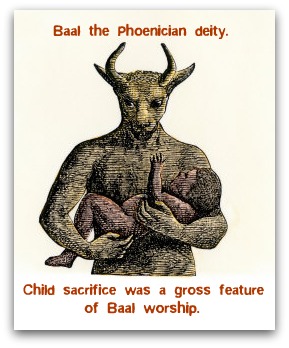
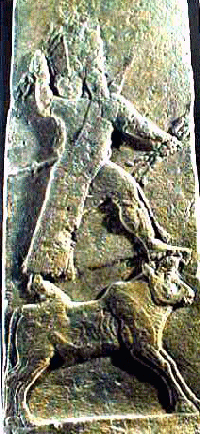 The two animals that - in the Temple - represented the sins of the priests and people were the BULL and the GOAT. Both were burned with fire outside the city (as indeed was the Harlot as being part of the same system Rev 17:17).
The two animals that - in the Temple - represented the sins of the priests and people were the BULL and the GOAT. Both were burned with fire outside the city (as indeed was the Harlot as being part of the same system Rev 17:17).
Baal's cult animal was the bull, though at times and in different places he was also associated with goats and even flies. He is sometimes shown in Near Eastern art standing on the back of a bull, [Source] as in this Phoenician stele to the left.
But notice that another animal associated with Baal was the GOAT with which we are more familiar today as a symbol of satan. This was the other animal sacrificed at the time of Yom Kippur.
The Harlot, Bride of Satan
We tend to see the Harlot as a different entity to the beasts, yet we have an exact parallel to the Church (or Israel if you prefer) and God. As Israel was the wife of God, so the Church is joined to her Head Jesus Christ as one Body.
Redemption comes from our being identified as One with Christ, sharing the same name, righteousness and destiny. When God looks on his Son he sees us abiding there; equally when he looks upon us he looks at the perfect righteousness of Jesus Christ with whom we have joined as one spirit.
That is exactly why the Apostle Paul referred to our relationship with God as a kind of marriage, the perfect union of Adam and Eve, of Man and Woman. Two become one! Therein lies our salvation. Ephesians 5:31-32 "For this cause shall a man leave his father and mother, and shall be joined unto his wife, and they two shall be one flesh. This is a great mystery: but I speak concerning Christ and the church." 1 Cor 6:17 "But he that is joined unto the Lord is one spirit."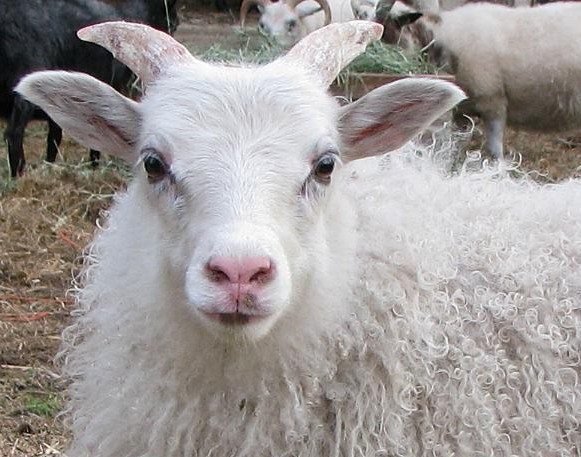
But here we have in Revelation another woman, once faithful but now adulterous, having fallen away from her true Lord. To John of Revelation she was undoubtedly apostate Israel, persecuting Jesus Christ and the believers. Today she is apostate religion of every kind, the fallen woman. And instead of being one with God, she is now ONE WITH THE DEVIL.
Both she and the Beast that she straddles are crimson, as is the "father-god" who possesses and inspires them - the red Dragon. They are in that sense a composite beast, and she is so closely related to (married to) her beast lover that the two become ONE. Thus, we do have the two beasts of Revelation seen here in the wilderness, and while the leopard-like beast is political Babylon, she is Mystery Babylon the religion. The lamb-like beast with horns is the Prophet of Babylon and ALL are satanic!
The Twin Goats
There were of course TWO goats used at Yom Kippur. They were intended almost to be two parts of one animal, being as near identical in appearance, age and size as possible. They were therefore two aspects of the same symbol - the sin of Israel.
BOTH goats were killed, one by fire and the other by being driven away to the wilderness carrying the sins of the people. This demonstrates the two-fold redemption by the blood of Jesus: the covering of sins by the blood sacrifice and the entire removal of the body of sin by death and resurrection. They are therefore two aspects of the SAME redemption!
NOTE: We know that Jesus Christ was the fulfillment of both goats of Yom Kippur. As the "Goat for the Lord" he was sacrificed and died outside the city. As the "Scapegoat" he bore the sins of all mankind, and carried them far away to the 'heart of the earth' from which they originated. [Matthew 12:40] But what we should realise here, as relevant to this study, is that the scapegoat did not survive. The Scapegoat of Jesus did NOT escape death! The bible demanded that sin be removed as well as atoned, and Jesus "descended into the lower parts of the earth" Eph 4:9 for that purpose. He perfectly fulfilled this Old Testament type. By the way, far be it from me to suggest that - as some say - Jesus had to suffer in hell for three days to atone for our sins. What I have said does not imply that doctrine. Jesus entered the place of the righteous dead (not hell) as a Victor! It was his perfect obedience and his shed blood that brought about the atonement.
Beasts in the Wilderness
Revelation 17:3 John needs to be taken into the wilderness to witness the fate of the beasts, because nobody in the Temple worship of Yom Kippur would be able to see the fate of the Azazel goat. The scapegoat in those days was conveyed to a distance so far outside the city (further than a Sabbath-day journey) that it could never find its way back.
Leviticus 16:8, says: "Aaron shall cast lots over the two goats, one lot for the Lord and the other lot for Azazel." One goat was "for the LORD" and the other was "for Azazel" - or simply the one word Azazel - which seems to imply by a parallel meaning, that the other goat was "for sin, or for the devil" or even just "the devil". The Azazel goat was to return sin back to the devil where it belongs, and realising this, the Jews cast it down violently as if to throw it back into the PIT. What the angel says about it in Revelation 18 is very similar.
The Sin-Offering Goat
The "goat for the Lord" is killed inside the Temple at Yom Kippur and its blood is presented to God. It is a sin-offering that satisfies the perfect justice of God. Importantly, unlike the bullock and the Azazel, no attempt is made to lay hands upon this sacrificial goat to transfer the sins of the people. No confession is made over this goat. Its role was to shed its blood. This goat was the Lord's but the other (Azazel) was the PERSONIFICATION OF SIN itself! It became sin!
If there are those who object, what else does the scripture mean in that "He - Jesus - BECAME sin for us" and in His Body removed our sins by taking them "into the depths of the earth" where they belonged. 2 Corinthians 5:21 "For He made Him who knew no sin to be sin for us, that we might become the righteousness of God in Him." If Jesus our Saviour did not become sin, you could not become righteousness. You could be forgiven, and cleansed, but could never have freedom from sin! (In other words, you would still be under the LAW.)
Jesus. the Perfect Sin-Offering, shed his blood to cover the sins of mankind, but he did not stop there. He then presented it - that is Himself - before the Throne of the Father just as did the High Priest with the goat's blood. Hebrews 9:11-12 says: "Christ came as High Priest --- Not with the blood of goats and bullocks but with his OWN blood He entered the Holy of Holies once and for all, having obtained eternal redemption." He was destined to be both goats at the same time. He both shed his blood AND died as an Outcast.
In summary, the live sin offering was a means whereby the unexpiated sin of the community could be gathered up and returned to its source, Azazel, to await the final Judgement and eternal destruction. Returning to the Apocalypse, there is a striking resemblance between Azazel and Satan. [Source]
So in Revelation. There were two goats. BOTH were destined to die! One died in the fire but the other died by being cast off a high place, and both these are the fate of Babylon.
The Red Cord
Here is another striking similarity between the Azazel "devil-goat" and Revelation's beasts: the crimson cord or cloth. After the lot had been cast to choose which of the two identical goats was to be designated as "scapegoat" Azazel, it was identified by having a woolen crimson tag tied around its horns.
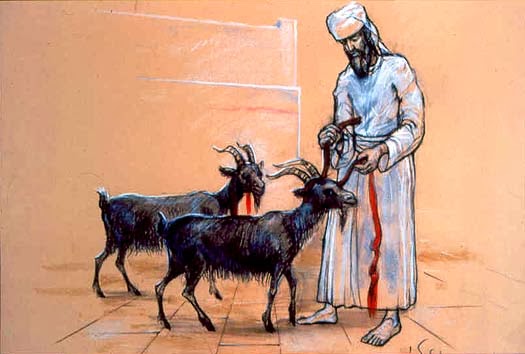
A portion of this red cloth was also removed from the goat and tied to the Temple door. Tradition says that each year the red cloth on the Temple door turned white when the goat in the wilderness died to signify the atonement of Yom Kippur was acceptable to the Lord. Sin had been removed. Isaiah the prophet had said: ''Come, let us reason together, saith the LORD: though your sins be as scarlet [crimson], they shall be white as snow; though they be red like crimson, they shall be as [white] wool'' (Isaiah 1:18).
Whether or not the Jews realised it, this crimson cord, the colour of blood, was a further representation of the sins of the people. Now when we are presented with the Dragon of Revelation - Satan himself - and also the Beast in which he incarnates, and also the woman who rides him - ALL are crimson! This cannot be a coincidence. They are all marked out as AZAZEL, the devil incarnate, ultimately to be cast into the pit from whence they came.
What is Azazel?
Through the translation of the bible into English we have named this second goat the "scapegoat", That is, the goat that escaped. But in the original Hebrew of the text, the word is simply AZAZEL. Nobody knows what this word means exactly and there is much speculation. One writer comments, "Ehrlich succinctly summarized the situation saying, 'Azazel—No one knows who he is or what he is. What previous scholarship said about him has no substance and cannot be relied upon.' This is also true at the present time, almost a century later." For an in-depth discussion please go to THIS PAGE.
The Jews made the word fit the action and came up with "the goat that goes away", and this is the meaning picked up later by the Septuagint, Vulgate and some other ancient sources. They see the first part of the name Azazel to come from the word עז ('ez), meaning she-goat, and the second part, they say, comes from the verb אזל (azal), meaning to go away. There's one problem with this. In Leviticus 16 the word עז (she-goat) is never used but always שעיר (sa'ir), meaning he-goat!
But an equally valid translation of the Hebrew word, adopted by many Jewish thinkers, is Azaz-El which means "fierce god, or strong god" and is therefore more applicable to the devil. By John's day, and the time of Herod's Temple, the Azazel was seen as synonymous with the devil that tempted mankind to sin (See for example an interesting account here. )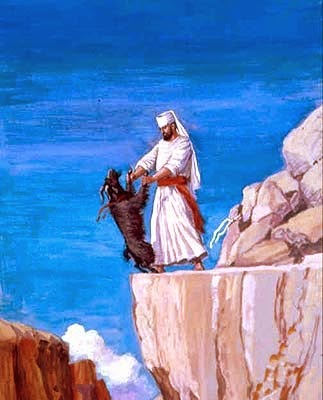
But as far as scripture is concerned, the word implies the removal of corruption. Strong's concordance gives the meaning as "complete removal". Wikipedia says "In the Bible, the goat for Azazel was a goat that was designated (Hebrew לַעֲזָאזֵֽל la-aza'zeyl) to be outcast in the desert..."
The scapegoat was cast out as corrupted, depraved and full of sin, and it is not intended to remain alive. It personifies all the sins of the people, and could not be allowed to perhaps wander back into the city precincts in that condition. It is intended to waste away and die in the wilderness or at the very least be lost eternally. By John's day the death of the goat was made certain by throwing the goat off a cliff.
In Revelation 18:21 we see a strong angel pronouncing the doom of Babylon, both the political power and the apostate religion, in a way strikingly similar: by hurling a great stone into the sea. (Rather akin to the "great mountain" that was hurled into the sea when the dragon was cast out.). But this destruction of Babylon is a reflection of the passage in Jeremiah 51.
Jeremiah had written on a scroll about all the disasters that would come upon Babylon--all that had been recorded concerning Babylon. He said to Seraiah, "When you get to Babylon, see that you read all these words aloud. . . . When you finish reading this scroll, tie a stone to it and throw it into the Euphrates. Then say, `So will Babylon sink to rise no more, because of the disaster I will bring upon her. And her people will fall.'" (Jer 51:60-61, 63-64) The curse on Babylon in Jeremiah's day is echoed in the words of the mighty angel: With such violence the great city of Babylon will be thrown down, never to be found again (v. 21). The parallel is striking because Jeremiah had written of Babylon's judgment on a scroll, and a scroll was used to introduce all the judgments in the book of Revelation. ... The image of the millstone has yet another source, closer to John's time than the prophecies of Jeremiah. Jesus said to his disciples that if anyone "shall offend" (KJV) or "put a stumbling block" (NRSV) before one of Jesus' "little ones," it would be better for that person "to be thrown into the sea with a large millstone tied around his neck" (Mk 9:42). [Source]
Surely the words of Jesus about putting a stumbling block before Jesus' disciples or "causing them to sin" apply so perfectly to Mystery Babylon! She not only deceived the disciples and the rest of the world with her false teachings but persecuted and slaughtered them as well, "for in her was found the blood of prophets and of the saints, and of all who have been killed on the earth (v. 24). She is "drunk with the blood of the saints" and "those who bore testimony to Jesus" (17:6). Because she offended the "little ones" who belong to Jesus, she is thrown into the sea, to sink like a stone and never be seen again.
Raise Your Right Hand!
Before we leave the subject of the two goats we need to see yet another parallel between the Yom Kippur service and the book of Revelation - a particular practise in choosing of the lots for the two goats. "And he shall take the two goats, and present them before the Lord at the door of the Tent of Meeting. And Aaron shall cast lots upon the two goats; one lot for the Lord, and the other lot for Azazel... " (Lev. 16) A wooden lottery box was kept in the Temple, within which were the two lots. On one lot the two Hebrew words meaning "For the Lord" were written, and the other was inscribed with single word "For Azazel."
The High Priest thrusts his hands into the lottery box and stirs the two lots within, to make sure all is equal. It was considered an auspicious sign from Heaven if the lot "for the Lord" was drawn by his right hand; thus he mixes the lots about so that he will not recognize them.
So the High Priest raised up the two lots from the box, one in his right hand and one in his left. Only once he held them up did he learn which hand held each lot. If his right hand held the lot of "For the Lord," the assistant would declare "Master! High Priest! Raise up your right hand!" And hearing this cry, all those assembled would know that this favorable sign has indeed transpired.
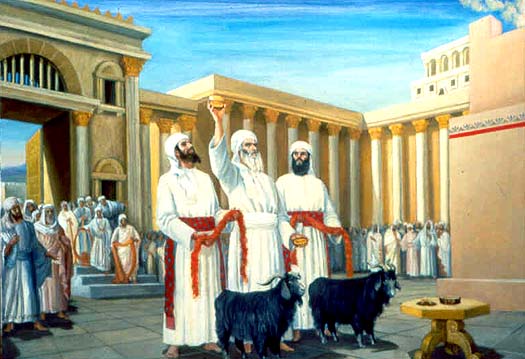
There is an amazing reference in the Talmud concerning this: "Forty years before the destruction of the Temple (ie. from the death of Jesus onwards) the lot did not come up in the right hand..." [Talmud Bavli, Yoma 39b]
But at this point in Revelation we have an angel holding up his right hand. (Rev 10:5)
The same "strong angel" who had prophesied the seven thunders and given the little book to John (also a prophecy?) now holds up his right hand and (since there are no lots cast in heaven) swears by the Lord that the doom of Babylon is certainly coming - and soon! That means, the choice has been made, those who are to die are must die, those who are to be saved will be saved. For he announces the time of completion as that of the seventh trumpet - so now we must hurry on to see those events.
That will be the time (just before the final destruction) that the "mystery of God" will have been completed, so says the mighty angel.
There has been some discussion about the precise nature of this mystery. The closest we can come is other passages in scripture that hint of it, such as Colossians 1:25-27 and Romans Rom 15:15,16 where "the mystery that has been kept hidden for ages and generations" is the inclusion of the Gentiles in the plan of salvation.
Jesus physically returns to Earth having completed the full number of Gentile believers: "For I would not, brothers, that you should be ignorant of this mystery, lest you should be wise in your own conceits; that blindness in part is happened to Israel, until the fullness of the Gentiles be come in. And so all Israel shall be saved: as it is written, There shall come out of Zion the Deliverer, and shall turn away ungodliness from Jacob." (Romans 11:25-26)
In short, the entire Yom Kippur afternoon ceremony shows us the emergence and prophesied destruction of sin and the devil as personified by the beasts of Revelation. Next - the three narrative interludes given us by John while we wait for the news that Azazel has reached the wilderness.
If you are interested, intrigued, confused, or just want to give me some feedback, please e-mail me direct: Contact Page
© 2014 Tricia Tillin-Booth. All rights reserved. Birthpangs Website: http://www.birthpangs.org/ This document is the property of its author and is not to be displayed on other websites, redistributed, sold, reprinted, or reproduced in printed in any other format without permission. Websites may link to this article, if they provide proper title and author information. One copy may be downloaded, stored and/or printed for personal research. All spelling and phraseology is UK English.

